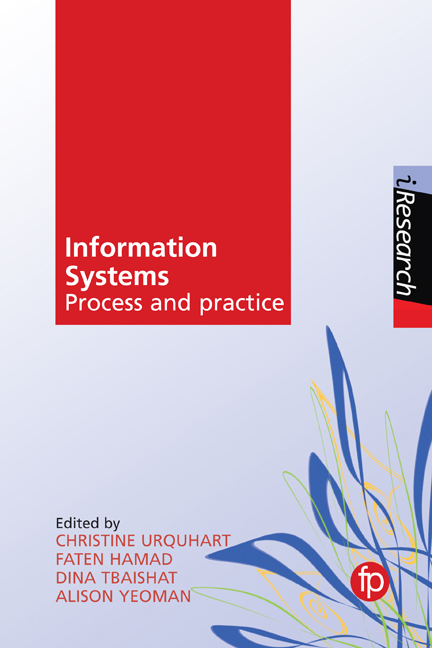Book contents
- Frontmatter
- Contents
- List of tables and figures
- Series editor's foreword
- About the authors
- 1 Introduction
- 2 Approaches to information architecture
- 3 Taxonomy testing for information architecture
- 4 The enterprise website and its information structures
- 5 Analysing activities, roles and processes
- 6 Libraries and the organisation of library processes – a history of operational research, and the use of process modelling
- 7 Using Riva process modelling to study book acquisition in academic libraries
- 8 Workflow analysis and process mapping in US academic libraries
- 9 A theoretical framework for designing and evaluating semi-structured document triage interfaces
- 10 Resource discovery case studies
- 11 Increasing social connection through a community-of-practice-inspired design
- 12 Methods for studying information provision, networking and communication in patient support groups
- 13 Health information systems: clinical data capture and document architecture
- 14 Producing systematic reviews and getting evidence to the clinician
- Index
5 - Analysing activities, roles and processes
Published online by Cambridge University Press: 08 June 2018
- Frontmatter
- Contents
- List of tables and figures
- Series editor's foreword
- About the authors
- 1 Introduction
- 2 Approaches to information architecture
- 3 Taxonomy testing for information architecture
- 4 The enterprise website and its information structures
- 5 Analysing activities, roles and processes
- 6 Libraries and the organisation of library processes – a history of operational research, and the use of process modelling
- 7 Using Riva process modelling to study book acquisition in academic libraries
- 8 Workflow analysis and process mapping in US academic libraries
- 9 A theoretical framework for designing and evaluating semi-structured document triage interfaces
- 10 Resource discovery case studies
- 11 Increasing social connection through a community-of-practice-inspired design
- 12 Methods for studying information provision, networking and communication in patient support groups
- 13 Health information systems: clinical data capture and document architecture
- 14 Producing systematic reviews and getting evidence to the clinician
- Index
Summary
Introduction
This chapter introduces some of the terminology used in chapters 6, 7 and 8 on process modelling. Chapter 7 explains how to apply a particular business process modelling technique called Riva, but other approaches can be taken and the current chapter starts with an overview of what is meant by ‘use cases’ and how use case descriptions help when trying to analyse activities. This is followed by a brief explanation of object-oriented analysis and unified modelling language (UML). This is extremely brief, but we need to put some aspects of systems analysis and modelling into place against some library work that may be familiar to most readers. We cannot do much more here than indicate that there is work going on, for example, on the Functional Requirements for Bibliographic Records (FRBR) to map FRBR to other schemes that use an object-oriented approach. Despite efforts to implement a more systematic and unified approach, using UML, business systems analysis methods continue to diverge in ways that sometimes make conversations between library staff and the IT developers more difficult. It is very easy to get bogged down in the detail of mapping from one modelling method to another, and forget the big picture of how the processes actually fit together. The chapter concludes with an overview of the Riva methodology for deriving the process architecture for an organisation (or library service within an organisation).
Chapter 4 emphasised that the practice of information architecture may be fluid, and that roles and responsibilities may be diffuse. It is therefore important to be able to check the big picture of what is going on, and to identify the important processes and how they relate to the business of the organisation.
Section 5.2 discusses what the term use case means and how use cases are used in information systems modelling. Section 5.3 explains basic process concepts, Section 5.4 explains how to derive a process architecture, and there are conclusions in Section 5.5.
Modelling the functions of an information system – use cases
Digitisation has changed many of the activities undertaken by libraries by introducing new functions, changing roles and relationships among different staff roles. Jisc work on digitisation and documents often refers to use cases, for example the use cases of the Copac Collection Management (CCM) Tools Project (https://ccm.copac.jisc.ac.uk/use-cases/).
- Type
- Chapter
- Information
- Information SystemsProcess and Practice, pp. 71 - 84Publisher: FacetPrint publication year: 2017
- 1
- Cited by

